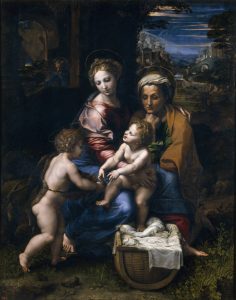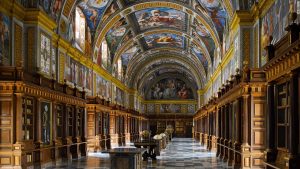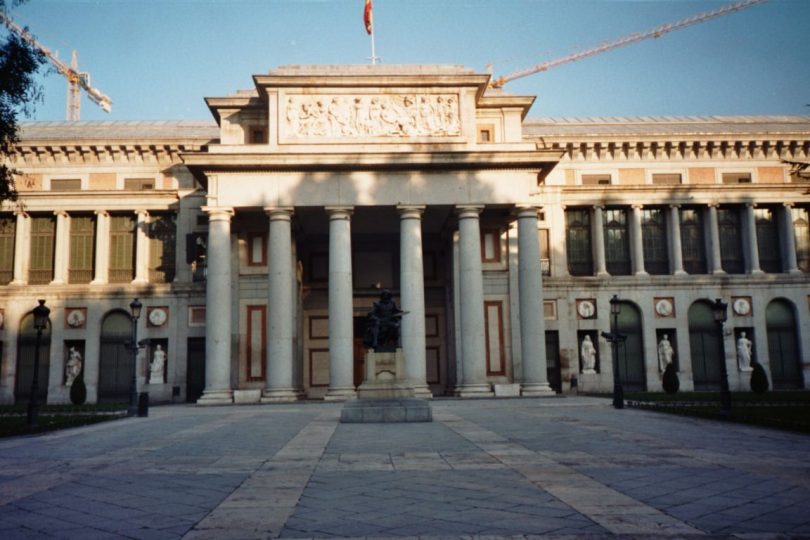
CLICK ON IMAGE TO SEE HIGH DEFINITION. Raffaello Sanzio, Raphael, The Holy Family (The Pearl) -1518.
One of the most fabulous paintings that forms part of the Prado´s collection is made by famous Italian painter Raffaello Sanzio da Urbino (1483-1520), better known as Raphael.
The Pearl of the collection
Together with Michelangelo and Leonardo da Vinci, Raphael forms the traditional trinity of the great masters of the High Renaissance. Raphael’s amazing painting, that is located in the Prado Museum in hallway 49*, is an image of the Holy Family and also known by the name “the Pearl” (la Perla in Spanish), as it was King Felipe IV´s favourite painting among all those in his collection.
Famous painting in Prado Museum
There is some disagreement as to who painted it, but the drawing of the composition is generally attributed to Raphael, who would have given it to Giulio Romano, one of his students, to finish the painting.
The painting depicts a scene of the holy family existing of Maria looking at little Jesus and little Saint John the Baptist who is wearing a clothing of camel’s hair, as written in the bible. Standing beside Maria is her cousin Saint Elisabeth, who became pregnant by a holy miracle of Saint John at a very old age, while St. Joseph sits in the background on the left. They are watching their children while Maria places an comforting arm around Saint Elisabeth who probably already expresses her concerns about the uncertain future.
Secret Message
The secret behind the painting is the fact that these four holy people actually never were mentioned together in any part of the bible at this stage. The two infants would meet, but only later on as adults, when Jesus was baptised, and this scene never took place at all in the bible, and was completely invented by Raphael.
So why did Raphael painted exactly this particular scene? One of the theories that goes around says that Raphael based the scene upon the secret manuscript of Apocalipsis Nova**. This secret, and never officially published manuscript was written by Portuguese Monk Amadeus Mendes da Silva. His polemical manuscript was highly criticized by the existing church then as it was full of unorthodox ideas, and therefore prohibited. It is very probably though that Raphael knew of the existence of the manuscript that was circling around among cultured people in Europe at the time, and that this painting is Raphael’s secret reference to the manuscript.
End of the world
In 1518, when the painting was made, Europe was on the edge of a holy collapse. The influence of church had severely decreased by Luther’s upcoming ideas, corruption scandals at the Vatican, the upcoming Islam and the discovery of South America. On top of that an apocalyptic event was predicted for 1524 that the world would end soon thus increasing an overall intense feeling of fear and doom everywhere.
It was obviously a very uncertain time in Europe then, and by depicting this extraordinary scene Raphael probably tried to express all these uncertain feelings in this extraordinary, beautiful painting by also secretly referring to the manuscript of the Apocalypsis Nova.
You can find a copy of the manuscript of Apocalypsis Nova in the library of the royal monastery of San Lorenzo de El Escorial.

Click on image to see high definition. The library of Escorial is one of the most important historic libraries in the world. It contains almost 45,000 printed works from the 15th and 16th centuries, and some 5,000 manuscripts in Arabic, Latin, and Spanish. Its original furnishings are in an excellent state of preservation. The ceiling is decorated with frescoes by Italian Pellegrino Tibaldi related to the sciences and learning.
*The Prado is still refurbishing parts of the museum and paintings still get moved around all the time, so it can happen that the painted is not located in this hallway anymore when you are going to check it out. Just ask any of the guards out there, they are very helpfull and always speak some English.
New Revelation
**The Apocalypsis Nova ( or ‘New Revelation’) is a doctrinal prophecy written in Latin at the end of the of the 15th century that describes the allegedly revelations given to the Franciscan friar Amadeo Mendes da Silva who was the confessor of Sixtus IV and the founder of the, today extinct, congregation of the amadeits who were followers of Amadeo.
This theological manifesto circulated widely as a manuscript and prophesized the upcoming of the Angelic Pope who would unite the two churches and convert all infidels under the same faith (unum ovile et unus pastor, John 10:16). It also dealt with theological and exegetical matters, such as the creation of the world or the Inmaculate Conception together with other unorthodox and polemical contents.






